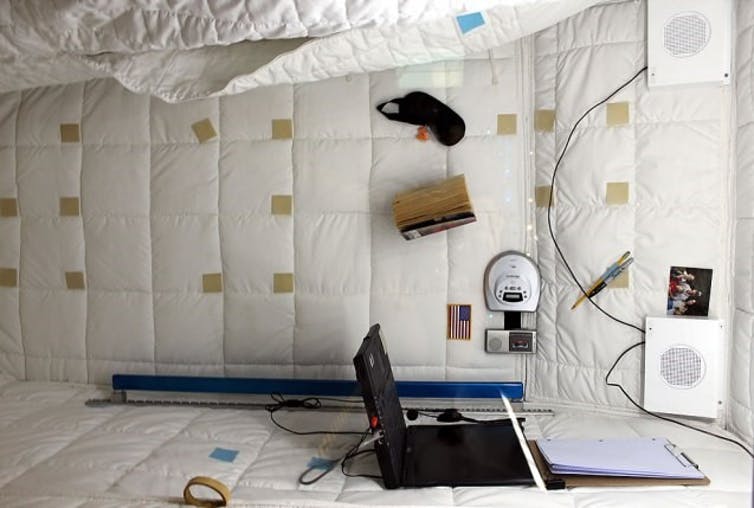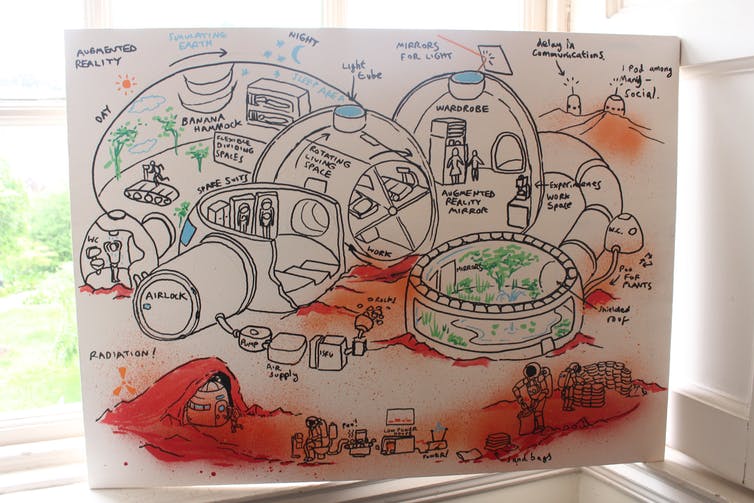Five things you need to do to build a home on Mars
- Transfer

If you had to live the rest of your life on Mars, what would you miss most? To come up with a way of comfortable existence on the Red Planet is not an easy task, but the more often there is a question about sending people to Mars, with the final goal of colonizing this planet, the clearer it becomes necessary to understand how to replace the feeling of the sun on your face or grass under your feet.
Fortunately, we have plenty of experts. On May 16, 2018, I [ author Lucy Bertaud, professor of engineering and space at the University of Bristol ] organized a seminar at the University of Bristol in collaboration with local artists Ella Good and Niki Kent, in order to develop a house plan before it will be built in 2019. We have already identified five major things, inspired by such research projects as Biosphere-2 and the desert research station Mars in Utah, USA.
1. Create a personal space and purpose
Employees of the architectural firm Hugh Broughton Architects, who developed the British Antarctic research station Haley-6, helped us with the design of the Martian home . They say that the need for personal space and privacy in a small-sized home is crucial. This problem is already faced by people living in small homes. In order to solve this problem in the best way, there should be small personal places in houses in the Martian settlement, and houses should be grouped into several pieces.

Living room on ISS
In addition to the settlement plan, which takes into account the need for a personal space, for the psychological support of the inhabitants they need to have a goal, task, or work that brings returns. Anyone who has moved to another home in another place, deliberately or unwillingly, will tell you about it. On Mars, tasks can be completely different, from geology and botany to equipment maintenance.
2. Waste minimization
Another key feature of cosmic dwelling is a closed cycle. As much material as possible should fall into the category of renewable or recyclable: energy, fuel, food and garbage. Life in space, and on Mars, must first be effective. There is a rather remarkable parallel with technologies that show themselves well in developing countries: we will need to grow food, engage in research and experimentation, processing air, water and garbage with minimal energy costs.
Resource-scarce places like refugee camps can help us with ideas about new food systems and recycling on another planet. Solar energy and compost from prepared human waste are excellent examples of closed-loop technologies.
3. Find building materials on site
As for the direct construction of the buildings themselves, you can take advantage of the experience of James Norman , a civil engineer engaged in various types of buildings on Earth. He says that building with sacks — a technology in which local soil can be used, filling it with durable sacks, and building inexpensive and reliable structures — can be an ideal method because space transportation of building material from Earth may be unacceptable. Martian settlement Bob Mayhil , a geologist from the University of Bristol, who worked on the NASA InSight landing gear

, confirmed that this method can provide the construction of local shield materials from radiation of suitable thickness, required on Mars.
4. Grow greens
On Mars, among other things, we probably will miss the greenery, so the task of recreating vegetation through the terraforming procedure may become important . Fortunately, we know that, in principle, it is possible to assemble land-like ecosystems from their constituent components. For example, botanists investigated the question of how to create copies of ancient forests . Exploring the replicas of ancient forests can teach us how to create complex biological communities in the future.
5. Develop familiar sensual sensations.
As for the familiar sensations, which we all will miss when leaving Earth - perhaps augmented reality can help in this matter. Recent studies show how important sensory aspects of the environment are for people's health and well-being. According to Utah Leonards , a cognitive neuroscientist from Bristol, the environments we create directly affect our ability to function. Augmented reality, with plants, water and circadian rhythms, can help create an environment that supports a person’s personality. It can help emotional survival in a brave new world.
